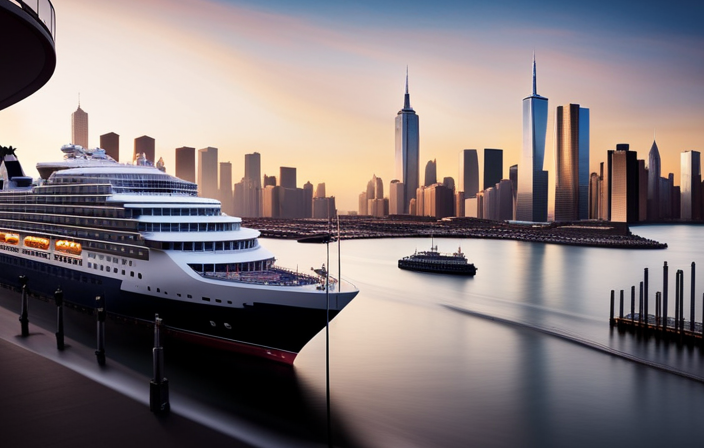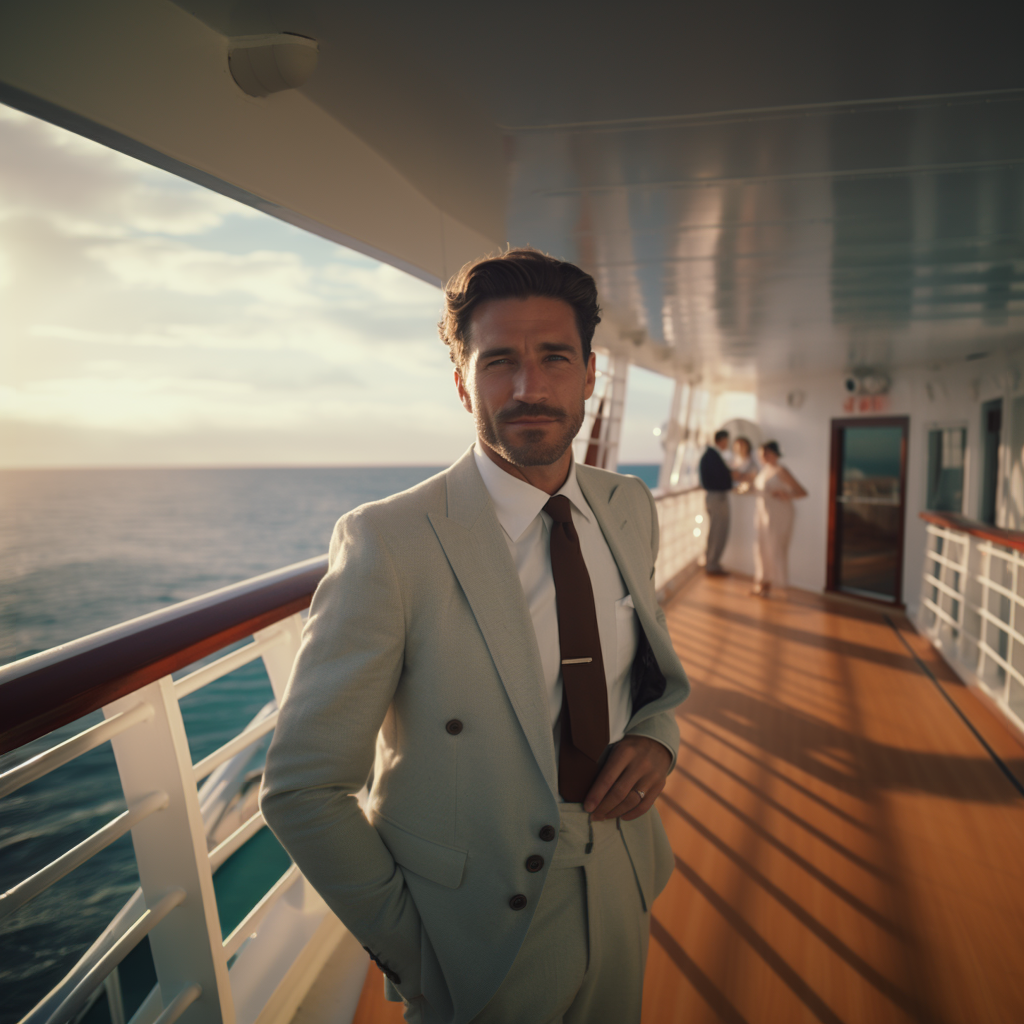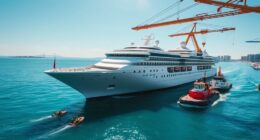Stepping onto the luxurious deck of a Royal Caribbean cruise ship, I’m greeted by the brisk, salty air, stirring feelings of anticipation and thrill within me. The lavishness and opulence surrounding me are testament to the success and ownership of this esteemed cruise line.
So, who owns Royal Caribbean Cruise Line? Let’s delve into the fascinating story behind this industry giant.
Founded in 1968 by three Norwegian shipping companies, Royal Caribbean has since become a global leader in the cruise industry. Over the years, the ownership of the company has evolved, with various stakeholders playing a role in its expansion and success.
Today, the major shareholders of Royal Caribbean Cruise Line include institutional investors, mutual funds, and individual investors. With its publicly traded status, the company continues to thrive through strategic partnerships, joint ventures, and a commitment to financial performance.
Join me as we explore the remarkable journey of Royal Caribbean Cruise Line and its impact on the world of cruising.
Key Takeaways
- Royal Caribbean Cruise Line was founded in 1968 by three Norwegian shipping companies and has since experienced significant growth and development in the industry.
- The initial founders and early stakeholders, including co-founder Arne Wilhelmsen, played a crucial role in establishing the company and investing in its success.
- Through strategic expansion and acquisitions, Royal Caribbean has become a dominant force in the industry, with notable acquisitions including Celebrity Cruises, Island Cruises, Pullmantur Cruises, and Silversea Cruises.
- The company’s major shareholders, primarily institutional investors and mutual funds, hold 65% of total shares and play a crucial role in shaping the company’s direction and decision-making.
The Origins of Royal Caribbean Cruise Line
Royal Caribbean Cruise Line was founded by three Norwegian shipping companies back in 1968. The origins of Royal Caribbean can be traced back to the merger of Anders Wilhelmsen & Company, I.M. Skaugen & Company, and Gotaas Larsen. These three companies came together to create a new venture in the cruise industry, aiming to provide innovative and luxurious travel experiences.
Over the years, Royal Caribbean has experienced significant development and growth, expanding its fleet and introducing groundbreaking features such as the first-ever ice skating rink and rock climbing wall on a cruise ship. Today, Royal Caribbean is one of the largest cruise lines in the world, offering a wide range of destinations and onboard amenities.
Moving on to the founders and early stakeholders, let’s explore the key individuals who played a crucial role in shaping the company’s success.
Founders and Early Stakeholders
One of the individuals responsible for the establishment and initial investment in Royal Caribbean Cruise Line was a co-founder named Arne Wilhelmsen. Alongside his friends Anders Wilhelmsen, Edwin Stephan, and Knut Kloster, Arne played a crucial role in laying the foundation of the company.
These founders were determined to create a cruise line that would offer innovative and high-quality experiences to travelers.
In addition to the founders, there were also early stakeholders who contributed to the success of Royal Caribbean Cruise Line. These stakeholders included financial institutions and private investors who recognized the potential of the cruise industry.
Their investments helped fuel the growth and development of the company. With the support of these individuals, Royal Caribbean Cruise Line embarked on a journey of expansion and acquisition of other cruise lines.
Expansion and Acquisition of Other Cruise Lines
Royal Caribbean Cruise Line has significantly expanded its reach and solidified its position as a leading player in the industry through strategic expansion and the acquisition of various cruise companies. This expansion has been driven by effective acquisition strategies that capitalize on the strengths of other cruise lines while minimizing competition. As a result, Royal Caribbean has been able to gain a larger market share by absorbing smaller competitors.
Here are some notable acquisitions made by Royal Caribbean:
-
In 1997, Royal Caribbean acquired Celebrity Cruises, which enhanced its luxury offerings and attracted a more upscale clientele.
-
In 2000, the company acquired Island Cruises, allowing it to enter the British cruise market and expand its European presence.
-
The acquisition of Pullmantur Cruises in 2006 expanded Royal Caribbean’s reach in the Spanish-speaking market and strengthened its position in Europe.
-
The purchase of Silversea Cruises in 2018 further solidified Royal Caribbean’s foothold in the luxury cruise segment.
With these strategic acquisitions, Royal Caribbean Cruise Line has positioned itself as a dominant force in the industry, attracting a diverse range of customers. In the subsequent section, we will explore the current major shareholders of the company.
Current Major Shareholders
The current major shareholders of the company hold a staggering 65% of the total shares, indicating a strong level of confidence in the company’s performance and potential.
The ownership structure of Royal Caribbean Cruise Line is primarily composed of institutional investors and mutual funds.
The largest shareholder is Capital Research and Management Company, with a significant stake in the company.
Other major shareholders include The Vanguard Group and BlackRock.
These shareholders play a crucial role in shaping the company’s direction and decision-making.
It is worth noting that the ownership structure can change over time as shareholders buy or sell their holdings.
Moving forward, it is important to consider Royal Caribbean Cruise Line’s publicly traded status and how it impacts the company’s operations and future growth.
Publicly Traded Status
With its publicly traded status, Royal Caribbean Cruise Line can attract a wide range of investors and access capital for future growth opportunities. As a publicly traded company, Royal Caribbean’s ownership structure is composed of shareholders who own shares of the company’s stock. These shareholders can be individual investors, institutional investors, or mutual funds.
Being publicly traded also means that Royal Caribbean is subject to regulatory requirements and must provide transparency to its shareholders by issuing quarterly and annual financial reports. This allows potential investors to assess the company’s performance and make informed investment decisions.
Now, let’s take a closer look at Royal Caribbean’s board of directors and the individuals who play a crucial role in guiding the company’s strategic decisions and overall governance.
Royal Caribbean’s Board of Directors
The individuals who make up Royal Caribbean’s board of directors play a crucial role in steering the company’s strategic decisions and overall governance. Royal Caribbean’s leadership is composed of experienced professionals from various industries, bringing diverse perspectives to the table. They are responsible for overseeing the company’s operations, ensuring compliance with regulations, and making key decisions that impact the business’s success.
Here is a snapshot of Royal Caribbean’s current board of directors:
| Name | Position | Expertise |
|---|---|---|
| Richard Fain | Chairman & CEO | Cruise industry |
| Arne Sorenson | Vice Chairman | Hospitality industry |
| William Kim | Director | Finance and investments |
| Laura Franklin | Director | Marketing and branding |
| Thomas Murphy | Director | Legal and governance |
Together, they bring a wealth of knowledge and experience to guide Royal Caribbean’s decision-making process. This strong leadership team sets the company’s direction and ensures its long-term success. Looking ahead, partnerships and joint ventures will further enhance Royal Caribbean’s growth and global presence.
Partnerships and Joint Ventures
Get ready to discover the exciting partnerships and joint ventures that are propelling Royal Caribbean’s growth and global presence! Royal Caribbean has actively sought out partnership opportunities and strategic alliances to enhance its offerings and expand into new markets. Here are three notable partnerships that have contributed to the company’s success:
-
Celebrity Cruises: Royal Caribbean acquired Celebrity Cruises in 1997, forming a strategic partnership to offer a premium cruising experience to a wider range of guests. This partnership has allowed Royal Caribbean to tap into the luxury cruise market and attract a more affluent clientele.
-
DreamWorks Animation: In 2010, Royal Caribbean partnered with DreamWorks Animation to bring characters like Shrek and Kung Fu Panda onboard its ships. This collaboration has created unique entertainment experiences for families, making Royal Caribbean a top choice for family vacations.
-
Joint Ventures in Asia: To capitalize on the growing Asian cruise market, Royal Caribbean has formed joint ventures with local partners. These partnerships have enabled the company to customize its offerings to suit the preferences and culture of Asian travelers.
These partnerships have not only expanded Royal Caribbean’s reach but also contributed to its financial performance and revenue sources.
Transitioning into the next section, let’s now explore the company’s financial performance and revenue sources.
Financial Performance and Revenue Sources
In the previous subtopic, we discussed the partnerships and joint ventures of Royal Caribbean Cruise Line.
Now, let’s delve into the financial performance and revenue sources of the company.
As a leading player in the cruise industry, Royal Caribbean Cruise Line has implemented effective strategies to drive revenue growth. The company has focused on expanding its fleet, offering innovative onboard experiences, and expanding into emerging markets.
These initiatives have contributed to the company’s strong financial performance, with steady revenue growth over the years.
Additionally, Royal Caribbean Cruise Line has diversified its revenue sources by offering a range of services including onboard entertainment, dining, and shore excursions. This multifaceted approach has helped the company to remain competitive and capitalize on the growing demand for cruise vacations.
Moving forward, let’s explore the impact of Royal Caribbean Cruise Line on the cruise industry as a whole.
Impact on the Cruise Industry
Impacting the cruise industry as a whole, Royal Caribbean Cruise Line’s innovative strategies and diversified revenue sources have positioned it as a major player in the market.
The economic impact of the cruise industry on local communities is significant, as it generates employment opportunities and boosts local businesses. Royal Caribbean Cruise Line contributes to these economic benefits by operating in various destinations around the world, creating jobs and supporting local economies.
Additionally, the company is committed to environmental sustainability practices within the cruise industry. It has implemented measures to reduce its carbon footprint, improve waste management, and protect marine life. By investing in clean technologies and promoting responsible tourism, Royal Caribbean Cruise Line aims to minimize its environmental impact.
Transitioning into the subsequent section about ‘future outlook and growth strategies,’ the company’s commitment to sustainability and its focus on innovation position it for continued success in the evolving cruise industry.
Future Outlook and Growth Strategies
After discussing the impact of the pandemic on the cruise industry, it is now important to look ahead and examine the future outlook and growth strategies of Royal Caribbean Cruise Line. As the world begins to recover from the effects of COVID-19, the cruise industry is expected to make a strong comeback. Royal Caribbean is well-positioned to take advantage of this recovery by implementing future innovations and effective marketing strategies. The company has a track record of introducing groundbreaking features on their ships, such as their state-of-the-art entertainment options and innovative onboard activities. These future innovations will continue to attract new and repeat customers, ensuring the company’s growth. Additionally, Royal Caribbean’s marketing strategies, including targeted advertisements and partnerships with travel agents, will help to increase brand awareness and reach a wider audience. By focusing on these key areas, Royal Caribbean is poised for success in the future.
| Future Innovations | Marketing Strategies | Growth Strategies |
|---|---|---|
| Cutting-edge entertainment options | Targeted advertisements | Attracting new customers |
| Innovative onboard activities | Partnerships with travel agents | Retaining repeat customers |
| Advanced technology integration | Influencer collaborations | Expanding into new markets |
| Enhanced guest experiences | Social media campaigns | Building brand loyalty |
| Sustainable and eco-friendly initiatives | Promotions and discounts | Increasing market share |
Frequently Asked Questions
What are the most popular destinations offered by Royal Caribbean Cruise Line?
The most popular destinations offered by Royal Caribbean cruise line include the Caribbean, Mediterranean, Alaska, and the Bahamas. These destinations offer a variety of experiences, from pristine beaches to cultural excursions, making them highly sought after by travelers.
How many ships are currently in Royal Caribbean’s fleet?
Royal Caribbean currently has a fleet of 27 ships. These ships can accommodate a large number of passengers, with some carrying up to 6,680 guests. The average length of a Royal Caribbean cruise is 7-9 nights.
What are the main amenities and activities available on Royal Caribbean cruises?
Onboard activities on Royal Caribbean cruises include pools, water slides, rock climbing walls, mini-golf, theaters, casinos, and spa facilities. Main amenities include multiple dining options, bars, lounges, fitness centers, and shops.
Does Royal Caribbean offer any special programs or benefits for frequent cruisers?
Yes, Royal Caribbean offers a loyalty program called Crown & Anchor Society. Members enjoy exclusive benefits like priority boarding, onboard discounts, and access to private events.
How does Royal Caribbean prioritize environmental sustainability in its operations?
Royal Caribbean prioritizes environmental sustainability by promoting green initiatives and reducing its carbon footprint. The company invests in advanced technologies, such as energy-efficient ships and waste management systems, to minimize its impact on the environment.
Who is the owner of Carnival Cruise Line and does it have any relation to Royal Caribbean Cruise Line?
Carnival Cruise Line is owned by Carnival Corporation, which is a separate entity from Royal Caribbean Cruise Line. As of now, the carnival cruise stock price has been fluctuating due to the impact of the global pandemic on the cruise industry.
Is Royal Caribbean Cruise Line Offering Any Special Deals?
Yes, Royal Caribbean Cruise Line is currently offering special deals for those looking to find affordable cruise deals. With various promotions and discounts available, it’s a great time to book a cruise and save some money while enjoying a fantastic vacation experience.
Conclusion
In conclusion, Royal Caribbean Cruise Line has had a remarkable journey since its inception. The company has a diverse range of stakeholders, including founders, early investors, and major shareholders. It has grown through expansion and strategic acquisitions. As a publicly traded company, Royal Caribbean has formed partnerships and joint ventures to enhance its offerings.
With strong financial performance and revenue sources, the company has made a significant impact on the cruise industry. Looking ahead, Royal Caribbean’s future outlook and growth strategies promise to propel it even further. It is like a majestic ship sailing through the sea of success.
Alfons is the visionary leader and driving force behind Voyager Info’s success. As the Editor in Chief, he brings a wealth of experience and an unwavering passion for travel to the helm of our cruise-centric platform.
With a lifelong fascination for exploring new horizons, Alfons discovered his love for the ocean and cruising at a young age. From sailing across pristine Caribbean waters to embarking on daring expeditions to far-flung destinations, he has amassed a treasure trove of first-hand experiences in the world of cruising.











